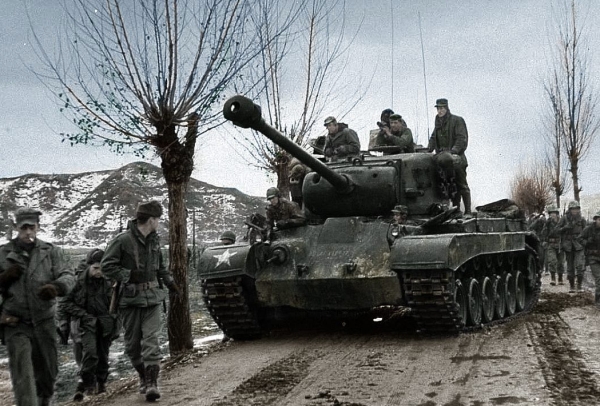
Gilbert Check, had conducted a daring reconnaissance in force more than 15 miles into enemy territory one day, then fended off a determined enemy attack on the regimental command post (CP) the next morning. Two weeks before the Battles of the Bowling Alley began, the 27th’s 1st Battalion, under Lt. DeChow, joined Murch’s 2nd Battalion at the Naktong Bulge. When reassigned to the 27th, the 3rd Battalion, commanded by 41-year-old Lt. Earlier, on July 24, the 3/29th had landed in Pusan and then lost almost half its men three days later battling elements of the NKPA 6th Division. A third battalion–the 3rd Battalion of the 29th Regiment–was seconded to Michaelis’ 27th on August 7. Murch, also 37 years old, had faced tough challenges during the Battle of the Naktong Bulge, driving hard into the southern face of the enemy’s penetration. The 2nd Battalion, commanded by Lieutenant Colonel Gordon E. In the early part of August, the 2nd and 3rd had been used to attack the southern face of the Naktong Bulge in support of the 24th Infantry Division. Someone said, ‘Who’s that?’ Someone else replied, ‘That’s Colonel Michaelis, our new commander.’Īll three of the 27th’s battalions had seen battle. Walker’s chief of staff broke the news, then added: ‘Your plane leaves in 45 minutes.’ Michaelis recalled, ‘I put $25, a razor, and tooth brush in my pocket and took off.’ When Michaelis arrived at Pusan, I was aboard a troop ship, and vividly recall seeing this lone figure on the dock, standing with feet spread and hands on hips. His assignment to command the 27th came suddenly. He reverted to the rank of lieutenant colonel for that duty, but was publicly praised by Eisenhower as one of four lieutenant colonels in the Army ‘of extraordinary ability.’ When the Korean War broke out, Michaelis was in the G-3 (operations) Section of the Eighth Army in Japan. On his return to duty, he was appointed chief of staff of the 101st Airborne Division until the end of the war, then served as aide-de-camp to General Dwight D.
#KOREAN WAR TANK BATTLES FULL#
Just three days shy of his 38th birthday when he got this tough assignment, he was a 1936 graduate of West Point, had risen to the rank of full colonel in World War II and commanded an airborne infantry regiment until he was wounded. Michaelis was a commander in whom Walker had a great deal of confidence. His orders were to secure Taegu from enemy penetration from that direction. He responded by moving without delay the regiment’s headquarters along with one reinforced battalion to a point across the Kumho River three miles north of Taegu on the Tabu-dong-Sangju road.

On August 17, the Eighth Army handed the assignment of stopping the NKPA’s initial advance towards Taegu to the commander of the 27th, Colonel John H. Eighth Army and United Nations forces in Korea at the time, chose to use the regiment as one of his ‘Fire Brigades’–detached units that were rushed at crucial times to shore up threatened areas in the Pusan Perimeter.īy August 14, the ROK 1st Infantry Division, guarding a segment of the perimeter north of Taegu, was reporting that an enemy regiment with six tanks had entered the village of Kumwha, just two miles north of Tabu-dong. It was normally attached to the 25th Infantry Division, but Lt. The 27th Infantry played an unusual role in the early anxious moments of the war. One nightmare scenario had it that from Pusan, the NKPA could end the war by pushing American and South Korean units into the sea. The stakes in this contest were very high: If the North Koreans could break through the 27th’s defense, they could barrel down to Taegu, the site of Eighth Army and ROK Army headquarters, capture its key communications center and rail line, then be in a position to threaten Pusan–the city that on August 18, as a result of the NKPA’s ability to shell Taegu, had been declared the temporary capital of South Korea, and now housed President Syngman Rhee’s government. As an officer of the 27th Infantry, I happened to be both an eyewitness and a participant in this one, a grueling seven nights of armored attacks against United Nations infantry and artillery units.

There were many onslaughts against the Pusan Perimeter in the course of the struggle. Army’s 27th Infantry Division (‘Wolfhounds’) and the Republic of Korea’s (ROK) 1st Infantry Division faced off against a determined effort by the North Korean People’s Army’s (NKPA) 1st and 13th Infantry divisions to break through this segment of the Pusan Perimeter. There, between August 18 and 25, 1950, the U.S. The Battles of the Bowling Alley took place in a narrow valley north of Tabu-dong, Korea, on the Taegu-Sangju road. Korean War: Battles of the Bowling Alley | HistoryNet Close


 0 kommentar(er)
0 kommentar(er)
